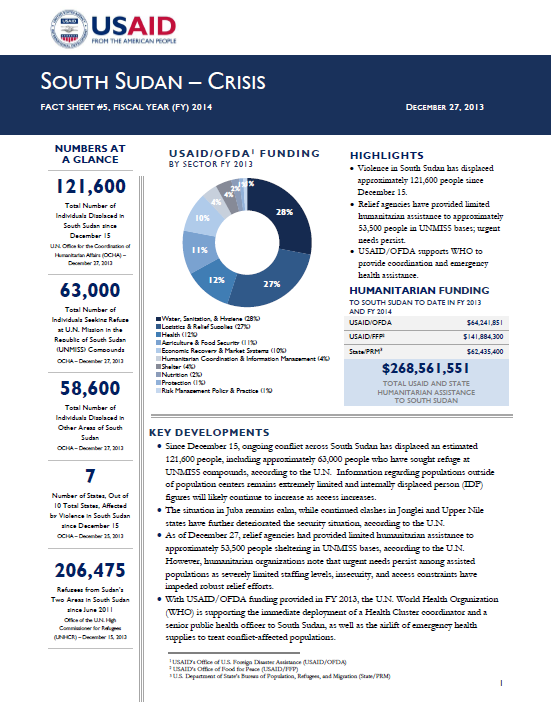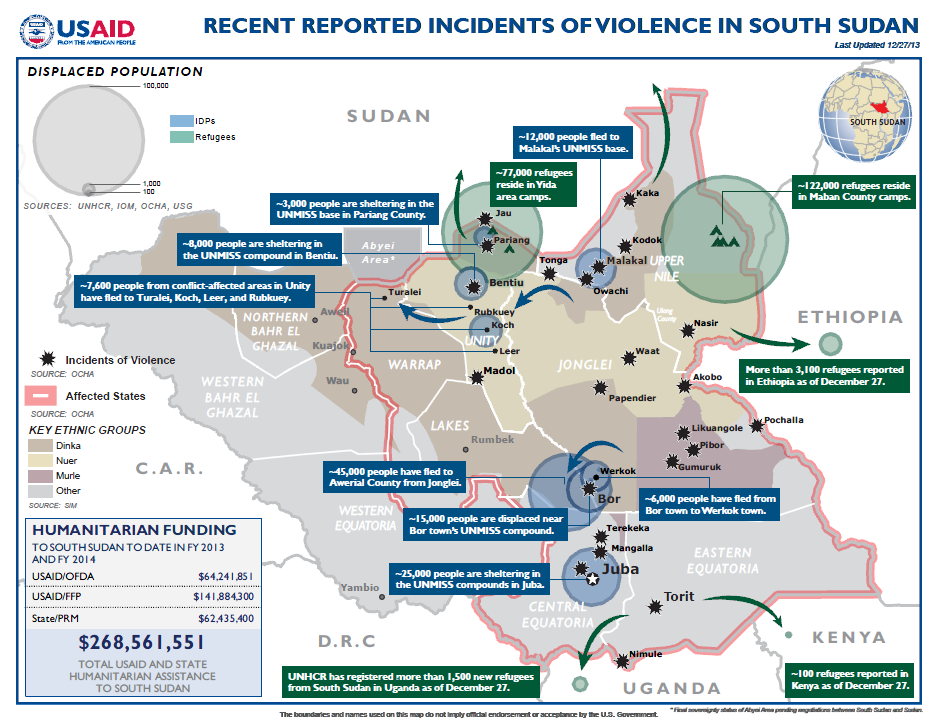- What We Do
- Agriculture and Food Security
- Democracy, Human Rights and Governance
- Economic Growth and Trade
- Education
- Environment and Global Climate Change
- Gender Equality and Women's Empowerment
- Global Health
- Humanitarian Assistance
- Transformation at USAID
- Water and Sanitation
- Working in Crises and Conflict
- U.S. Global Development Lab
Speeches Shim
June 13, 2014
Numbers At A Glance
1,130,300
94,200
1,036,100
382,900
239,200
Humanitarian Funding:
To South Sudan To Date In FY2014:
| USAID/OFDA | $110,000,000 |
| USAID/FFP | $147,400,000 |
| USAID/AFR | $14,200,000 |
| State/PRM | $73,300,000 |
| TOTAL | $344,900,000 |
Highlights
More than 1,600 cholera cases reported since April 23
Relief agencies scale up nutrition interventions in hard-to-reach, conflict-affected areas
Voluntary relocation to a new civilian protection site begins in Malakal town, Upper Nile State
KEY DEVELOPMENTS
Health agencies reported more than 1,600 suspected and confirmed cases of cholera—including 37 deaths—in South Sudan between April 23 and June 12. Despite increased efforts to treat and prevent cholera cases, the Government of the Republic of South Sudan (RSS) Ministry of Health (MoH) warns that the cholera outbreak is not yet contained.
With nearly 94,200 internally displaced persons (IDPs) sheltering at UNMISS protection of civilians (PoC) sites across South Sudan, humanitarian agencies continue concerted efforts to improve living conditions for IDPs. In early June, IDPs began relocating to a new PoC site in Malakal, where more than 18,000 IDPs are sheltering at the UNMISS base.
Relief agencies are closely coordinating humanitarian activities in Leer County, Unity State, following increased concerns regarding food insecurity and malnutrition in the area. Humanitarian agencies are providing treatment for severely malnourished children and delivering nutrition supplies, including 1,000 cartons of ready-to-use therapeutic (RUTF) foods, the U.N. reports. The U.N. World Food Program (WFP) and the International Committee of the Red Cross (ICRC) are working together to ensure coverage for vulnerable populations and link ICRC food distributions with WFP blanket supplementary feeding programs.
INSECURITY, DISPLACEMENT, AND ACCESS CONSTRAINTS
Hostilities in South Sudan since December 15 have displaced approximately 1.5 million people, including approximately 1.1 million IDPs and 382,900 people who are seeking refuge in neighboring countries.
The U.N. received recent reports of fighting south of the Sobat River near Nasir and Ulang counties, Upper Nile, as well as gunfire near Rubkona and Bentiu towns, Unity.
Insecurity and attacks against relief assets continue to hinder response activities in conflict-affected areas of South Sudan. For instance, two WFP-contracted trucks traveling from Wunrok town, Warrap State, en route to Bentiu struck a landmine on June 6, approximately 3 kilometers (km) west of Mayom town, Unity, according to the U.N. No deaths or injuries were reported. Further, on June 7, defected soldiers looted a WFP-contracted truck 40 km outside of Wau County, Western Bahr el Ghazal State, which was en route from Juba town, Central Equatoria State, to Wunrok to deliver food assistance.
HUMANITARIAN NEEDS ASSESSMENTS AND RESPONSE ACTIVITIES
From June 1–9, the U.N. Children’s Fund (UNICEF), the U.N. Food and Agriculture Organization (FAO), and WFP deployed field teams through the integrated Rapid Response Mechanism (RRM) to assist vulnerable populations in Wau Shiluk County, Upper Nile, and Jiech town, Jonglei State, reaching more than 38,000 people in Wau Shiluk and 15,000 people in Jiech, the U.N. reports.
WFP mobile food distribution teams are completing second round food distributions for more than 70,000 IDPs and conflict-affected people in Nyal and Mayendit towns, Unity, and Akobo County, Jonglei.
South Sudan Crisis Fact Sheet #46, June 13, 2014 ![]() (pdf - 274k)
(pdf - 274k)
South Sudan Crisis Map, June 13, 2014 ![]() (pdf - 948k)
(pdf - 948k)
CAMP COORDINATION AND CAMP MANAGEMENT
Relief agencies continue efforts to improve living conditions for IDPs living in UNMISS PoC areas. On June 9, Special Representative of the U.N. Secretary-General for South Sudan Hilde F. Johnson inaugurated a new PoC site adjacent to the UNMISS compound in Malakal. Approximately 4,500 IDPs had relocated to the new site—constructed to relieve congestion and improve IDP living conditions—as of June 6, according to the International Organization for Migration (IOM). The new site has the capacity to host between 8,000 and 9,000 people.
Camp coordination and camp management actors in Malakal are prioritizing IDP relocation based on vulnerability, special needs, and living conditions in the existing PoC area. Relief actors are constructing latrines, bathing areas, and a water treatment plan at the new site and increasing IDP access to safe drinking water with three new water tanks—each with the capacity to hold 70,000 liters of water.
Site preparations continue at the new PoC 3 site at Juba’s U.N. House. Relief actors organized a go-and-see visit for 50 community leaders from Juba’s Tomping site to PoC 3 on June 11, according to the U.N. The purpose of the visit was to allow the community leaders to assess living conditions at the new site to encourage voluntary relocations once the site opens. The visitors also received briefings on security from UNMISS and U.N. Police and on humanitarian service delivery. In addition to these go-and-see visits, the sensitization campaign to encourage relocation includes door-to-door messaging through outreach teams, daily radio messages, and poster displays.
Nearly 90 civilians had voluntarily moved from Tomping to U.N. House as of June 7 as part of a cash-for-work program to assist with the construction of shelters and other facilities at PoC 3. Relocations are scheduled to begin June 16, according to IOM.
AGRICULTURE, FOOD SECURITY, AND NUTRITION
Nearly 4 million people are likely to experience Crisis and Emergency—IPC 3 and 4, respectively—levels of food insecurity through August, according to the most recent IPC alert for South Sudan.[1] Meanwhile, relief agencies remain concerned regarding increased levels of malnutrition in the country, where approximately 235,000 children could face severe acute malnutrition (SAM) in 2014, the U.N. reports.
UNICEF continues to scale up nutrition interventions in hard-to-reach, conflict-affected areas, reaching 14 targeted sites as of June 11.
Médecins Sans Frontières (MSF) is responding to the health and nutrition needs of approximately 1,600 children identified as experiencing SAM in Leer, the U.N. reports. The U.N. is coordinating with MSF to support the nutrition response in Leer, and UNICEF plans to conduct a measles vaccination campaign.
During a recent RRM mission to Walgak town, Jonglei, from May 15–29, relief agencies screened more than 3,600 children for malnutrition and referred 16 children for SAM treatment, according to the U.N. The multi-sector response team also vaccinated nearly 700 children against polio, provided Vitamin A supplements and deworming medication to more than 1,000 children, and registered nearly 200 unaccompanied asylum-seeking children.
As WFP continues to expand food assistance coverage across South Sudan, WFP estimates that food commodities reached approximately 600,000 people through its emergency operations with food assistance in May, in addition to approximately 590,000 people through its longer-term food assistance programs.
HEALTH AND WASH
Between April 23 and June 12, health actors had reported more than 1,600 cases of cholera, including 37 cholera-related deaths, in South Sudan. The case fatality rate—approximately 2.3 percent—remains above the U.N. World Health Organization (WHO) emergency threshold of 1 percent. The RSS MoH and WHO continue to lead response efforts in most-affected Juba and other affected areas.
Although humanitarian partners have reported fewer cases in recent days, particularly at the Juba Teaching Hospital and other cholera treatment centers, the RSS MoH notes that the cholera outbreak is not yet contained. The majority of cholera cases have occurred outside PoC areas, possibly due to the oral cholera vaccination campaigns conducted at U.N. House and Tomping, according to the RSS MoH. To date, more than 13,400 IDPs at Tomping and more than 6,200 IDPs at U.N. House have received two doses of the oral cholera vaccine.
Health and water, sanitation, and hygiene (WASH) partners continue to conduct social mobilization activities, such as promoting infomercials on cholera prevention, distributing pamphlets on early detection and cholera control, and making house-to-house visits, the RSS MoH reports. The RSS MoH released a statement on June 9 urging communities to remain vigilant by reporting suspected cases and seeking early treatment.
Acute respiratory infections, acute watery diarrhea, and malaria remain the top causes of morbidity in IDP camps in South Sudan, according to the Early Warning and Disease Surveillance System—a joint project between WHO and the RSS MoH. The agencies recommend that relief organizations and local health actors continue to strengthen public health measures to prevent and control these diseases.
LOGISTICS AND RELIEF COMMODITIES
The Logistics Cluster—the coordinating body for humanitarian logistics activities, comprising U.N. agencies, NGOs, and other stakeholders—airlifted more than 150 metric tons of humanitarian supplies between June 1 and 9 to Jonglei, Unity, and Upper Nile on behalf of six relief agencies, according to the U.N.
OTHER HUMANITARIAN ASSISTANCE
To date, international donors have provided more than $741 million—approximately 41 percent of the $1.8 billion total requested funding—to support humanitarian activities through the revised South Sudan Crisis Response Plan.



Comment
Make a general inquiry or suggest an improvement.